Points, lines, and surfaces
Points, lines, and surfaces are also subclasses of Immaterial clothing entity.
Lines
If you look at a shirt, you will see some lines. The Shirt Ontology contains the classes Armscye seam line, Side seam line, and Shoulder seam line.
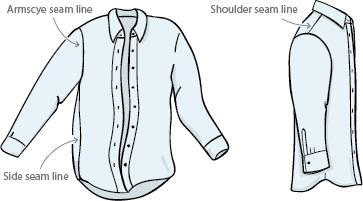
These visible lines are called “bona fide” lines. There is another category of lines, called “fiat lines”, which are not visible. Two of these are the Biceps line and the Elbow line of the Sleeve proper.
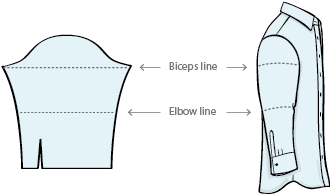
In the Shirt Ontology, these lines have been used to divide the Sleeve proper into regional parts.

Sleeve properhas regional partProximal region of sleeve proper, Intermediate regioin of sleeve proper, Distal regiion of sleeve proper
Surfaces
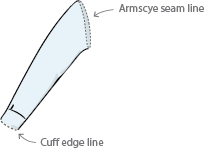 We can also refer to two-dimensional surfaces of the shirt, such as the
external surface of a sleeve. Surfaces are bounded by lines. In the case of
a sleeve, the surface is a tube, bounded at one end by the Armscye seam line and at the other by the Cuff edge line.
We can also refer to two-dimensional surfaces of the shirt, such as the
external surface of a sleeve. Surfaces are bounded by lines. In the case of
a sleeve, the surface is a tube, bounded at one end by the Armscye seam line and at the other by the Cuff edge line.
The surface and the lines are related by an “is bounded by” relationship.
External surface of sleeveis bounded byArmscye seam line, Cuff edge line
Surfaces can be divided into regions. External surface of sleeve has been divided into Posterior external surface of sleeve and Anterior external surface of sleeve.

In order to define these regions, two additional classes of lines have been created: Lateral longitudinal line of sleeve (on the lateral side, from top of shoulder to cuff) and the Medial longitudinal line of sleeve (on the medial side, from underarm to cuff). If you suspect that those terms might have been made up just for the Shirt Ontology, you are correct. One task in making an ontology is to come up with names for things that don‘t already have names.
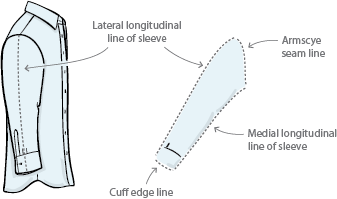
Anterior external surface of sleeveis bounded by
Armscye seam line, Cuff edge line,
Lateral longitudinal line of sleeve,
Medial longitudinal line of sleeve
Points
In order to more precisely describe Lateral longitudinal line of sleeve, we can refer to its endpoints. Therefore we must create classes for those points.
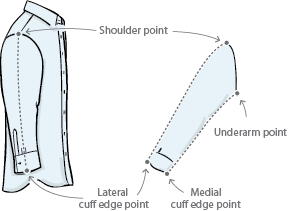
Lateral longitudinal line of sleeveis bounded byShoulder point, Lateral cuff edge point
Medial longitudinal line of sleeveis bounded byUnderarm point, Medial cuff edge point
In the FMA
The FMA follows this scheme for points, lines, surfaces, and volumes:
- Volumes (3D) are bounded by surfaces (2D)
- Surfaces (2D) are bounded lines (1D)
- Lines (1D) are bounded by points (0D)
A few examples are:
Heart (3D)is bounded bySurface of heart (2D)
Mediastinal surface layer of upper lobe of lung (3D)
is bounded by
Mediastinal
surface of upper lobe of lung (2D)
Mediastinal surface of upper lobe of lung (2D)
is bounded by
Anterior margin of upper lobe of lobe (1D),
Posterior margin of upper lobe of lobe (1D),
Fissural margin of upper lobe of lobe (1D)
Anterior margin of upper lobe of lobe (1D)
is bounded by
Anterior mediastinal point of upper lobe of lung (0D),
Apex of lung (0D)
The FMA contains classes for both bona fide and fiat lines. Bona fide lines include Vermilion border of upper lip and Vermilion border of lower lip. An example of a fiat line is the Midclavicular line, which is a vertical line extending from the middle of the clavicle (or collar bone) down to the hip bone.
